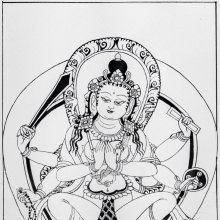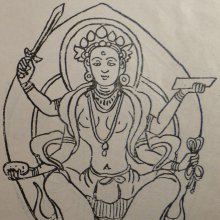Simhanatha, Siṃhanātha, Simha-natha: 1 definition
Introduction:
Simhanatha means something in Buddhism, Pali, Hinduism, Sanskrit. If you want to know the exact meaning, history, etymology or English translation of this term then check out the descriptions on this page. Add your comment or reference to a book if you want to contribute to this summary article.
Images (photo gallery)
In Hinduism
Shilpashastra (iconography)
Source: DSpace at Pondicherry: Siddha Cult in Tamilnadu (sculpture)Siṃhanātha (सिंहनाथ) refers to the third representation of the nine navanātha reliefs in the Ulsūr Someśvara temple.—The third Nātha in this series is seated on a striding lion. His head is slightly tilted upward. He is wearing kuṇḍalas on both the ears, cross band on his chest, rings on his arms and wrists. He is wearing a laṅgoti. His right hand is resting on his right leg and his left leg is resting on his left knee. An anklet is also shown on his right leg.
In the Ulsūr Someśvara temple, on the south wall of the ardhamaṇḍapa, there found depictions of the navanāthas (eg. Siṃhanātha) in a variety of poses with huge coffiures, holding attributes such as kamaṇḍala, daṇḍa (staff) and so on. From east to west the nine sculptures of the Nāthas appear in the following order: seated respectively on a Tortoise, Vyāli, Lion, Fish, Scorpion, Snake, Antelope, Boar and Tiger.

Shilpashastra (शिल्पशास्त्र, śilpaśāstra) represents the ancient Indian science (shastra) of creative arts (shilpa) such as sculpture, iconography and painting. Closely related to Vastushastra (architecture), they often share the same literature.
In Buddhism
Tibetan Buddhism (Vajrayana or tantric Buddhism)
Source: archive.org: The Indian Buddhist IconographySiṃhanātha (सिंहनाथ) or Siṃhanāthalokeśvara refers to number 20 of the 108 forms of Avalokiteśvara found in the Machhandar Vahal (Kathmanu, Nepal). [Machhandar or Machandar is another name for for Matsyendra.].
Accordingly,—
“Siṃhanātha is one-faced and four-armed and sits in Bhadrāsana, or in the European fashion, on a raised seat placed on the lotus. In his two right hands he carries the sword and the jewel, while the two left hold the book and the noose”.
The names of the 108 deities [viz., Siṃhanātha] possbily originate from a Tantra included in the Kagyur which is named “the 108 names of Avalokiteshvara”, however it is not yet certain that this is the source for the Nepali descriptions. Tibetan Buddhism includes schools such as Nyingma, Kadampa, Kagyu and Gelug. Their primary canon of literature is divided in two broad categories: The Kangyur, which consists of Buddha’s words, and the Tengyur, which includes commentaries from various sources. Esotericism and tantra techniques (vajrayāna) are collected indepently.
See also (Relevant definitions)
Partial matches: Natha, Simha.
Starts with: Simhanathalokeshvara.
Full-text: Simhanathalokeshvara, Maharajalilasana, Rajalilasana.
Relevant text
Search found 3 books and stories containing Simhanatha, Siṃhanātha, Simha-natha, Siṃha-nātha; (plurals include: Simhanathas, Siṃhanāthas, nathas, nāthas). You can also click to the full overview containing English textual excerpts. Below are direct links for the most relevant articles:
The Indian Buddhist Iconography (by Benoytosh Bhattachacharyya)
Jainism in Odisha (Orissa) (by Ashis Ranjan Sahoo)
Parsvanatha image at Dhabalesvara Temple, Baidyesvara < [Chapter 3: Survey of Jaina Antiquities in Odisha]
The Skanda Purana (by G. V. Tagare)
Chapter 7 - Worship of the Liṅga < [Section 1 - Kedāra-khaṇḍa]

